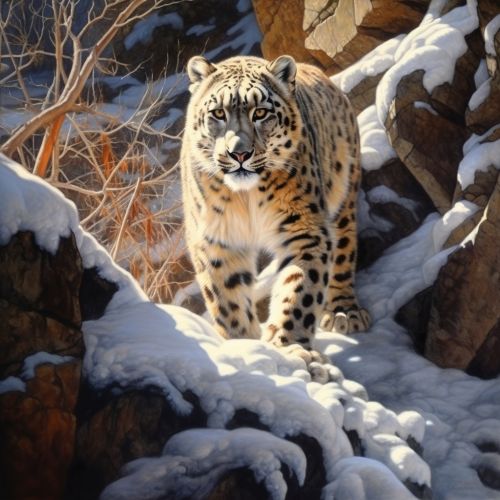The Biological Mechanisms of Animal Adaptation to Mountain Environments
Introduction
Mountain environments present unique challenges to the animals that inhabit them. These challenges include extreme temperatures, low oxygen levels, rugged terrain, and variable weather conditions. Animals that live in these environments have evolved a variety of biological mechanisms to adapt and survive. These adaptations include physiological, morphological, and behavioral changes that allow these animals to thrive in harsh conditions.


Physiological Adaptations
Physiological adaptations are changes in an animal's internal functioning to better cope with its environment. In mountain environments, these adaptations often involve changes to the animal's respiratory and circulatory systems to cope with low oxygen levels, as well as metabolic changes to deal with extreme temperatures.
Respiratory and Circulatory Adaptations
Animals living at high altitudes, where the air is thin and oxygen levels are low, have developed a number of adaptations to increase their oxygen uptake. For example, many high-altitude animals, such as the snow leopard and the yak, have larger lungs and a higher concentration of red blood cells compared to their low-altitude counterparts. This allows them to extract more oxygen from each breath and deliver it more efficiently to their tissues.


In addition to these changes, some animals have also evolved changes in their hemoglobin, the molecule that carries oxygen in the blood. For instance, the bar-headed goose, which migrates over the Himalayas, has a form of hemoglobin that binds oxygen more tightly, allowing it to function better at low oxygen levels.
Metabolic Adaptations
Metabolic adaptations are another important aspect of physiological adaptation to mountain environments. These adaptations allow animals to maintain their body temperature and energy levels in the face of extreme cold and limited food availability.
Many mountain animals, such as the alpine marmot and the pika, have developed a form of hibernation to survive the harsh winter months. During hibernation, these animals enter a state of reduced metabolic activity, which allows them to conserve energy and survive on their fat reserves.


Other animals, such as the snowshoe hare and the ptarmigan, undergo seasonal changes in their metabolic rate. In the winter, their metabolic rate increases to generate more heat, while in the summer, it decreases to conserve energy.
Morphological Adaptations
Morphological adaptations are physical changes that help an animal survive in its environment. In mountain environments, these adaptations often involve changes to the animal's body size, shape, and coloration.
Body Size and Shape
The size and shape of an animal's body can greatly influence its ability to survive in mountain environments. Many mountain animals are larger than their low-altitude counterparts, a phenomenon known as Bergmann's rule. This is because larger animals have a lower surface area to volume ratio, which helps them conserve heat in cold environments.
In addition to body size, the shape of an animal's body can also be adapted to mountain environments. For example, many mountain animals, such as the ibex and the bighorn sheep, have powerful, compact bodies and strong legs, which allow them to navigate steep, rugged terrain.


Coloration
Changes in coloration are another common morphological adaptation to mountain environments. Many mountain animals, such as the snowshoe hare and the ptarmigan, change their fur or feather color seasonally to blend in with their surroundings. This helps them avoid predators and increases their chances of survival.
Behavioral Adaptations
Behavioral adaptations are changes in an animal's behavior that help it survive in its environment. In mountain environments, these adaptations often involve changes in feeding habits, mating strategies, and social behavior.
Feeding Habits
Many mountain animals have adapted their feeding habits to cope with the limited food availability in their environment. For example, the grizzly bear and the mountain goat have a varied diet, which allows them to exploit a wide range of food sources.


Other animals, such as the pika and the alpine marmot, store food in the summer and fall to survive the winter months when food is scarce.
Mating Strategies
Mating strategies are another important aspect of behavioral adaptation to mountain environments. Many mountain animals, such as the bighorn sheep and the ibex, have developed complex mating rituals, which often involve males fighting for access to females.
Social Behavior
Social behavior is another important aspect of behavioral adaptation to mountain environments. Many mountain animals, such as the alpine marmot and the mountain gorilla, live in social groups, which can provide protection from predators and help with food gathering.


Conclusion
In conclusion, animals that live in mountain environments have developed a wide range of adaptations to cope with the unique challenges of their habitat. These adaptations, which include physiological, morphological, and behavioral changes, are a testament to the remarkable ability of animals to adapt to their environment.
